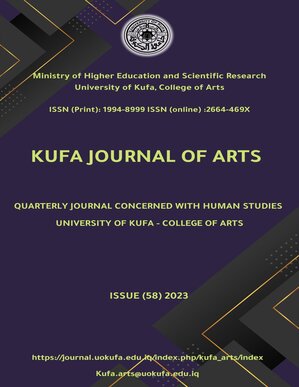(orders form)The bonds and opposites in comparing the speech of parents and children in the "Nahaju el Balagha'
DOI:
https://doi.org/10.36317/kaj/2023/v1.i57.12308Keywords:
argument act, hidden mening act, orders, directives, the result, the argumentAbstract
The analogy is one of the rhetorical mechanisms by which the argumentative work as an intercourse factor , and the uses of apostasy have reached the demands of persuasion since ancient times, because the argumentative is fumble, as it is one of the natural cosmic manifestations of humanity which differs and conforms to some perceptions, however it was not limited to science, or culture, but it is related to The existence of man, and his nature.
Besides, it works to help the bonds, the arguments that come up with the result of reinforce the purpose and the opposability of the speaker towards a specific destination by the speakers; the analogy is a technique of the 'Hajjaj' process, and the arguments are persuasive mechanisms, which were of the old rhetorical and modernists; it arouses the recipient's inherent capacity, working his thinking by researching and looking for a position that is similar between the two sides of the analogy, so the relationship that brings them together is the one that occupies the recipient, and urges persuading ; and directs the desired argument by the speaker only.
Accordingly, The researcher goes along with 'Hajjaji' analogue which combines the argument, the result, included the ties of 'Hajjaji coherence, namely( الواو, الفاء, او, ثم, and so on), the ties of 'Hajjaji' conflict, which are ( لكن and بل), and the links of 'Hajjaji reasoning include( the word cause, effect and so on). And the bonds of the Hijjaji' clause include the condition devices, and the opposites that helped to determine the result that Imam Ali (A.S) aimed in his speech containing the speech of parents and sons in the rhetoric approach, which will be the focus of our research.
Downloads
References
• آفاق جديدة في البحث اللغوي المعاصر، محمود أحمد نحلة، دار المعرفة الجامعية ,2002 م.
• الأساليب النحوية عرض وتطبيق، د.محسن علي عطية , دار المناهج ,عمان , الأردن,ط1, 2007.
• الأفعال الإنجازية في العربية المعاصرة، دراسة تداولية، ومعجم قياسي, علي محمود حجي الصراف ,مكتبة الآداب ,القاهرة ,ط1 ,2010م.
• بهج الصباغة في شرح نهج البلاغة، محمد تقي التستري، دار أمير كبير، طهران، ط1 , 1418ه.
• تصنيف نهج البلاغة، لبيب بيضون، مركز النشر التابع لمكتب الإعلام الإسلامي , قم , 1417هـ.
• توضيح نهج البلاغة، السيد محمد الحسيني الشيرازي، دار تراث الشيعة، طهران، بلا.
• الدرة النجفية في شرح نهج البلاغة، إبراهيم بن حسين الخوئي , بلا .
• شرح نهج البلاغة، عز الدين ابو حامد ابن أبي الحديد (ت 656ه)، تح: محمد أبو الفضل إبراهيم، مكتبة آية الله المرعشي النجفي العامة , 1378هـ .
• شرح نهج البلاغة، ميثم بن علي بن ميثم البحراني (ت699ه) , دفتر نشر الكتاب ,ط2, 1404هـ.
• شرح نهج البلاغة، السيد عباس الموسوي، دار الرسول الأكرم، دار المحجة البيضاء، ط1.
• علم نفس النمو، الطفولة والمراهقة، د. حامد زهران، دار المعارف ,1986 م.
• قواعد النحو العربي في ضوء نظرية النظم، د. سناء حميد البياتي، دار وائل، عمان ط1, 2003م.
• مفتاح العلوم، أبو يعقوب يوسف بن علي السكاكي (ت 626ه)، تح: د. عبد الحميد هنداوي، دار الكتب العلمية، بيروت- لبنان، ط1 ,2000.
New Horizons in Contemporary Linguistic Research, Mahmoud Ahmed Nahla, University Knowledge House, 2002 AD.
Grammatical Methods Presentation and Application, Dr. Mohsen Ali Attia, Dar Al-Manhaj, Amman, Jordan, 1st edition, 2007.
Achievement verbs in contemporary Arabic, a pragmatic study, and a standard dictionary, Ali Mahmoud Haji Al-Sarraf, Library of Arts, Cairo, 1st edition, 2010 AD.
Bahj al-Sabaghah fi Sharh Nahj al-Balaghah, Muhammad Taqi al-Tastari, Dar Amir Kabir, Tehran, 1st edition, 1418 AH.
Classification of Nahj al-Balaghah, Labib Beydoun, Publishing Center of the Islamic Information Office, Qom, 1417 AH.
Explanation of Nahj al-Balaghah, Sayyid Muhammad al-Husayni al-Shirazi, Shia Heritage House, Tehran, no.
Al-Durrah Al-Najafiyyah in explaining Nahj Al-Balaghah, Ibrahim bin Hussein Al-Khoei, BL.
Explanation of Nahj al-Balaghah, Izz al-Din Abu Hamid Ibn Abi al-Hadid (d. 656 AH), edited by: Muhammad Abu al-Fadl Ibrahim, Ayatollah Marashi al-Najafi Public Library, 1378 AH.
Explanation of Nahj al-Balaghah, Maytham bin Ali bin Maytham al-Bahrani (d. 699 AH), book publishing book, 2nd edition, 1404 AH.
Explanation of Nahj al-Balaghah, Sayyid Abbas al-Musawi, Dar al-Rasoul al-Akram, Dar al-Mahjah al-Bayda, 1st edition.
Developmental psychology, childhood and adolescence, d. Hamed Zahran, Dar Al-Maarif, 1986 AD.
The rules of Arabic grammar in the light of systems theory, d. Sanaa Hamid Al-Bayati, Dar Wael, Amman, 1st Edition, 2003.
Key to Sciences, Abu Yaqoub Yusuf bin Ali al-Sakaki (d. 626 AH), edited by: Dr. Abdul Hamid Hindawi, Dar Al-Kutub Al-Ilmiya, Beirut - Lebanon, 1st edition, 2000.
Downloads
Published
How to Cite
License
Copyright (c) 2023 إيمان مطر السُّلطانيّ ، أشواق باقر محسن

This work is licensed under a Creative Commons Attribution 4.0 International License.




















